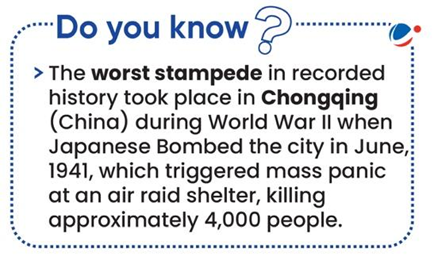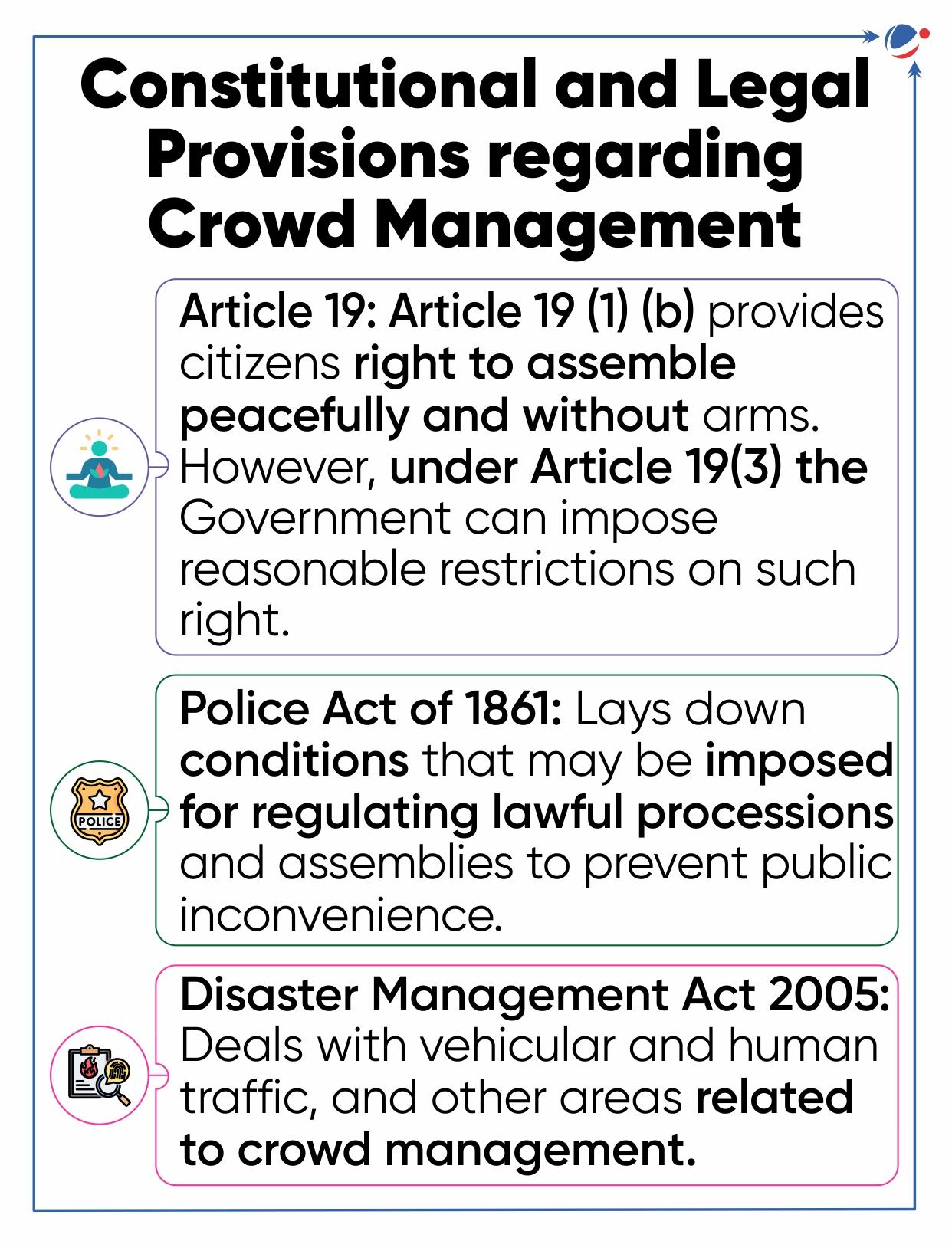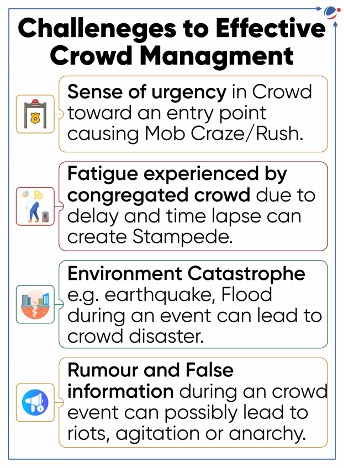Why in the news?
Recently a platform at Delhi's Kalkaji temple collapsed leading to injuries to many people including one death.
About crowd disaster
- A crowd is a group of people gathered together usually for a common purpose based upon emotions.
- Crowd movements involve a combination of voluntary and involuntary forces:
- Voluntary force: When crowd density is optimal, people’s movement is governed by social force (a physical response to a social interaction) which is a voluntary force.
- Involuntary: When crowd density is critical, people’s movement is governed by involuntary forces which includes pushing each other in a tightly packed situation.
- Such uncoordinated rush or push of people, may result in crowd disaster or stampede.
- Majority of the crowd disasters in India have occurred at religious places, venues of music concerts, night clubs and shopping malls.

Factors that may prompt crowd disasters are as follows
- Structural: Disaster caused by collapse of structures. Example, Morbi Bridge Collapse across Machchhu River in Gujarat.
- Fire/Electricity: Fire in the habitation or a shop, non-availability of fire extinguisher, short circuit from electrical generator, etc. Example, Uphaar Cinema Fire in 1997 that happened due to fire code violations.
- Administrative or Managerial Measures: Underestimation of audience/staffing/services, closed/locked exit, sudden opening of entry door, etc.
- Crowd Behaviour: Mad rush to exit/parking space, last minute change in platform for train arrival/departure, etc. Example, stampede at the Mahakumbh Mela in 1954.
- Security: Security agency firing/teargas/using force leading to panic, weapon brandished in the crowd, Ineptitude of the police in effectively enforcing prohibitory orders, etc.
- Example Seoul crowd tragedy (2022) happened primarily due to lack of safety precautions and other police errors.
- Lack of coordination among stakeholders: Such as lack of understanding of range of duties entrusted, communication delays, coordination gap between agencies, etc.
Disaster Management in India
 |
Crowd Management
- Risk management planning
- The first aim of any Crowd Management process is to prevent a serious situation from developing.
- Fruin, a renowned theorist in crowd behaviour, suggested FIST model to better understand the crowd behaviour and the causes of Stampede. FIST refers to
- F: Crowd Force
- I: Information upon which the crowd acts;
- S: Physical Space involved, both in terms of individual density and larger scale architectural features;
- T: Time the duration of the incident.
- This model is useful for venue operators and event organisers when developing proactive strategies to address the four elements of the model during event risk management planning.
- Governance: As crowd disasters are local events, its management is primarily the responsibility of the organizers and local/district administration with support, guidelines from the state and the national authorities.

NIDM’s Crowd Management Strategies and arrangement
- Understanding visitors and stakeholders: Knowing crowd type of (age, gender, region, etc.), Motives of visitors (social, entertainment), arrangement to provide timely information to the media personnel.
- Crowd management strategies and arrangement
- Capacity Planning:
- Infrastructure: Long term perspective is needed for infrastructure development and will depend on popularity, periodicity of event, weather, terrain, local population etc.
- Staging Points (queue complex): Plan for physical or virtual locations through which each visitor must pass
- Multiple routes to facilitate movement of vulnerable groups such as children, women, etc.
- Understanding Crowd Behaviour: Individual behaviour in a crowd is often influenced by behaviour of others. It is therefore essential to identify and separate trouble creating persons at the earliest.
- Research has shown that understanding of crowd behaviour has led to community-based approach to crowd control instead of force based control.
- Crowd Control: Crowd control enforces or restores order by restricting or limiting group behavior. For this:
- Ensure high visibility of crowd controlling Staff, involve various stakeholders including organizers/Temple trusts, Law enforcement agencies, Community stakeholders (NGOs, Business Associations, etc.).
- Capacity Planning:
- Risk Analysis and preparedness: Mock drills of the plan implementation may also lead to identifying the gaps in arrangements and fix them in advance.
- Other measures
- Timely Information Management and Dissemination among stakeholders
- Safety and security measures like CCTV monitoring of entire crowd, special plan for VIPs, ensure fire safety standards, etc.
- Health, Hygiene and Medical Services as Immediate medical attention after a fatal incident can save life.
- Use public transportation as much as possible and minimize the impact of undesired crowd and traffic.
Conclusion
Recurring stampedes at places of mass gatherings, which include religious places, railway stations and venues of sports/social/ political events, are of serious concern to the nation. However, since crowd disasters are essentially man-made, they can be prevented with holistic planning and efficient execution.



